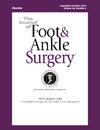跖骨头背屈闭合楔形截骨术与骨软骨自体移植治疗弗赖贝格病的比较研究:多中心分析。
IF 1.3
4区 医学
Q2 Medicine
引用次数: 0
摘要
弗莱贝格病(FD)是一种以影响跖骨头的骨软骨病为特征的疾病,其中第二跖骨头最常受到影响。跖骨头背屈闭合楔形截骨术(DCWMO)一直是传统的治疗方法,而骨软骨自体移植术(OAT)是一种较新的技术,但比较研究有限。本研究旨在比较 DCWMO 和 OAT 治疗弗赖贝格病(FD)的疗效。研究在两家机构之间分组。机构1采用OAT治疗(8名患者),机构2采用DCWMO治疗(8名患者)。所收集的主要结果包括并发症、活动范围、跖骨长度、美国骨科足踝协会轻度 MTP 指间关节(AOFAS-LMI)评分、视觉模拟量表(VAS)、足踝残疾(FADI)评分和短表-12(SF-12)。最终随访时,OAT 组的运动-FADI 和活动-FADI 评分明显高于 DCWMO 组(分别为 94.04 vs 84.75 和 97 vs 92,P = 0.021 和 P = 0.04),而 DCWMO 组最终随访时的跖屈明显低于 OAT 组(43.13 vs 6.88 度,P < 0.001)。最终随访时,DCWMO 组的 AOFAS-LMI 得分明显高于 OAT 组(86.75 vs 75.38,P = 0.013)。总之,本研究强调了 OAT 和 DCWMO 治疗弗赖贝格氏病的有效性,术后各种功能评分(包括 AOFAS-LMI、VAS 和 FADI)的明显改善证明了这一点。值得注意的是,OAT 在 SFADI 和 AFADI 以及跖屈 ROM 方面取得了良好的疗效,而 DCWMO 则改善了 AOFAS-LMI 评分。证据等级:3级。本文章由计算机程序翻译,如有差异,请以英文原文为准。
Comparative study of dorsiflexion closing wedge osteotomy of the metatarsal head and osteochondral autologous transplantation for Freiberg disease treatment: A multicenter analysis
Freiberg disease (FD) is a condition characterized by osteochondrosis affecting the metatarsal heads, with the second metatarsal head being the most commonly affected. Dorsiflexion Closing Wedge Osteotomy of the Metatarsal Head (DCWMO) has been conventionally employed, whereas Osteochondral Autologous Transplantation (OAT) represents a more recent technique with restricted comparative research. This study aimed to compare the outcomes of DCWMO and OAT for treating Freiberg disease (FD). Groups were established among two institutions. Institution-1 has made the treatment with OAT (8 patients) and Institution-2 has made the treatment with DCWMO (8 patients). The primary outcomes collected, including complications, range of motion, length of the metatarsal, American-Orthopaedic-Foot-and-Ankle-Society–lesser MTP-interphalangeal (AOFAS-LMI) score, visual-analog-scale (VAS), Foot-and-Ankle-Disability (FADI) score, and Short-Form-12 (SF-12), were all compared. The Sport-FADI and activity-FADI scores at final follow-up were significantly greater in the OAT group than in the DCWMO group (94.04 vs 84.75 and 97 vs 92, P = 0.021 and P = 0.04, respectively), whereas plantarflexion at final follow-up was significantly lower in the DCWMO group than in the OAT group (43.13 vs 6.88 degrees, P < 0.001). The AOFAS-LMI score at final follow-up was significantly greater in the DCWMO group than in the OAT group (86.75 vs 75.38, P = 0.013). In conclusion, this study highlights the effectiveness of both OAT and DCWMO in treating Freiberg's disease, as evidenced by significant postoperative improvements in various functional scores, including AOFAS-LMI, VAS and FADI. Notably, OAT demonstrated favorable outcomes in SFADI and AFADI and plantarflexion ROM, while DCWMO led to improved the AOFAS-LMI score.
求助全文
通过发布文献求助,成功后即可免费获取论文全文。
去求助
来源期刊

Journal of Foot & Ankle Surgery
ORTHOPEDICS-SURGERY
CiteScore
2.30
自引率
7.70%
发文量
234
审稿时长
29.8 weeks
期刊介绍:
The Journal of Foot & Ankle Surgery is the leading source for original, clinically-focused articles on the surgical and medical management of the foot and ankle. Each bi-monthly, peer-reviewed issue addresses relevant topics to the profession, such as: adult reconstruction of the forefoot; adult reconstruction of the hindfoot and ankle; diabetes; medicine/rheumatology; pediatrics; research; sports medicine; trauma; and tumors.
 求助内容:
求助内容: 应助结果提醒方式:
应助结果提醒方式:


